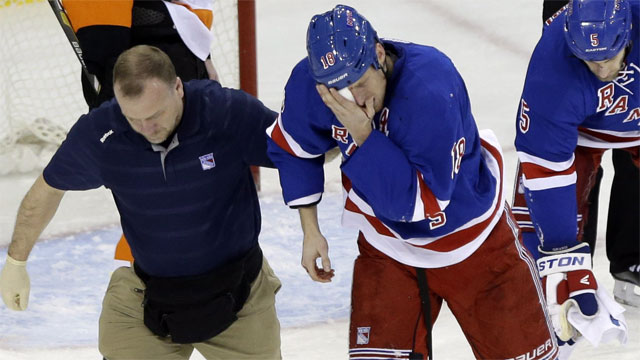TORONTO – No one really needed to see the sight of Marc Staal flailing around violently on the ice at Madison Square Garden to know that hockey players should protect their eyes with a visor.
But it may have taken that unfortunate incident in early March to finally bring about progress in the NHL.
How else to explain why just 30 per cent of players supported grandfathering in the use of visors back in 2009 and approximately 80 per cent do today?
The most recent figure came via a poll conducted by the NHL Players’ Association over the last week and resulted in Tuesday’s announcement by the competition committee that visors will be grandfathered in for all new players starting next season.
Until now, the NHLPA had vehemently defended the right of each player to choose whether he would use eye protection. It did so even as Bryan Berard, Manny Malhotra, Chris Pronger and others suffered eye injuries.
Eventually, the tipping point arrived.
Enough was enough.
It is no coincidence that it came at a time when more and more players were already choosing to wear visors on their own. Seventy-three per cent had one on in 2013. And according to Mathieu Schneider, the NHLPA’s special assistant to the executive director, some attitudes changed for good after Staal took a puck to the face.
“Without a doubt,” he said. “Every time there’s an injury like that, I think any player that’s playing without a visor starts to think about it or has his mom calling him or his wife telling him or his kids telling him. I dealt with that throughout my career.
“It’s a reason why the numbers (wearing them) are so high — frankly the numbers went up again and more guys put a visor on after the Staal injury this year.”
With the new rule in place, the feeling is that at least 80 per cent of NHL players will wear a shield next season. That number will eventually climb to 100 per cent as veterans leave the league or choose to adapt by wearing a visor themselves.
Officially, any player with at least 25 games of NHL experience (regular season or playoffs) at the end of this season will retain the right to choose.
Everyone else will simply continue to use the facial protection he has already grown comfortable with while coming up through junior, college, European pro leagues or the American Hockey League.
The NHL’s board of governors still has to sign off on the new visor protocol before it enters the rulebook, but that vote won’t take very long. The players are the league’s most important asset and top decision-makers have been waiting a long time for this day to come.
“We are very pleased,” NHL commissioner Gary Bettman told sportsnet.ca on Tuesday night.
Representatives from the league and union plan to sit down together next week in an effort to establish some rules and guidelines governing the use of visors. They will also speak with manufacturers about developing shields that are custom fit for each different type of helmet.
Colin Campbell, the NHL’s vice-president of hockey operations, indicated that rule 46.6 — which deems that an extra two-minute penalty will be assessed to a player who instigates a fight while wearing a visor — will be examined and likely changed.
“We’ve got to walk through all of that,” said Campbell, whose son Gregory plays for the Boston Bruins and doesn’t currently wear a visor.
There was clearly a feeling of change in the air as the competition committee gathered for its first meeting since the new collective bargaining agreement was signed back in January.
A group comprised of players, general managers, Flyers owner Ed Snider and Maple Leafs coach Randy Carlyle also agreed to test hybrid icing in the pre-season next year, adopt shallower nets designed to give players more room to maneuver and subject all four-minute high-sticking penalties to video review to ensure that the correct call was made on the ice.
They also decided to form a sub-committee that will be tasked with making future decisions on equipment — everything from goalie pads to shoulder pads and helmets.
However, it wasn’t any of those initiatives that had Schneider walking away from the NHL’s Toronto office on Tuesday night proclaiming that “an awful lot” had been accomplished.
The former NHL defenceman was clearly pleased to see the visor mandate move forward. He played more than 1,400 games in the league without one but started to think the time had come for a change in the wake of the serious injury suffered by Staal — one that will have long-lasting effects.
The 26-year-old New York Rangers defenceman isn’t expected to ever regain 100 per cent vision in his right eye — which was struck directly by a puck on March 5 — and has indicated that he hoped none of his peers would ever have to experience what he went through.
At least a few will almost certainly be spared now that players have decided to take the visor choice out of the hands of future generations.
“Overall, it’s just been a change in attitude,” said Schneider.
It’s a welcome change, indeed.

